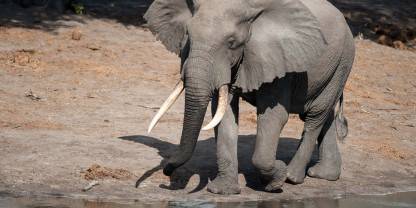Average Expert Rating
Rating Breakdown
Write a User ReviewExcellent elephant action at waterholes and quiet bush atmosphere
Read more
highlight – not luxurious but friendly and laid-back where the staff and guides, all employed from the vicinity, have a great personal knowledge and affection for the park.The sand forest home to South Africa’s last big tuskers
Aside from giving a home to these special elephants, Tembe’s main importance lies in protecting the largest tract of sand forest in South Africa. This delicate environment is home to an impressive variety of rare flora and fauna and the birding is phenomenal. The gracious nyala is very common and this is also a prime habitat for the secretive red duiker. Even more special
Read more
is the chance to see one of Africa’s smallest antelopes, the suni. I was lucky to see this shy territorial creature scurrying around camp at dusk.Walk of the elephants
Located on the border with Mozambique, Tembe Elephant Park is by far the best government-run game park for the Big Five in KwaZulu-Natal. In my opinion, it also comes a pretty close second to Kruger. Beyond the park’s namesake Elephant, the park is also home to larger mammals such as zebra, giraffe, wildebeest and hippo as well as a variety of antelope species including the world’s smallest antelope – the Suni which stands about 12-17 inches high to its shoulder. Noted for its vast swamplands and spectacular sand forests dominated by thickets of tall trees, Tembe is a wild, remote place that is very special indeed. Its true beauty, however, is only revealed if you allow yourself the time to spend a couple of nights in the park.
Tuskers of the Sand Forest
Read more
elephants and abundant general game, the overgrown sandy tracks of Tembe explore one of the last wild tracts of South Africa that still exudes a genuine wilderness feel.Elephants and special birds
Tembe is located in the far north of Zululand, bordering Mozambique, and interestingly is part-owned and run by the local Tembe tribe. There is only one lodge option, which is well-run and good value and we loved the staff singing to us on our arrival.
Tembe is renowned for its big elephants, although with the recent (natural) death of its biggest tusker, you will only see ‘emerging’ tuskers – i.e. young bulls who have still to develop into their prime. Don’t come to Tembe expecting to see the Big Five – the bush is very thick, and sightings are difficult. However, do come to Tembe for the rich birdlife, including some real specials found only in this remote part of South Africa. The guides are all skilled birders, and in three days we ticked off the African broadbill, pink-throated twinspot, lemon-breasted canary, grey waxbill, Eastern nicator, Rudd’s apalis and many more.
Southern Africa’s largest tuskers
Other wildlife is more difficult to spot. All the Big Five are present, but over the course of two visits, I have only encountered lion and buffalo once each, and I’ve yet to see a leopard or rhino. The reserve supports a dense population of nyala, a handsome antelope characteristic
Read more
of Zululand. On our most recent visit, we saw two troops of samango monkey, a species that is very rare in South Africa. Birding is potentially exceptional. The park is home to several localized bird species associated with the sand forest in northern Zululand. In general, guided drives tend to focus on looking for elephant and other large mammals.Tembe stands out for its remote location, relatively low tourist volumes and genuine wilderness feel (access is by 4x4 only). In addition, the local Tembe community operates a wonderful tented camp that offers very sensibly priced packages inclusive of meals and game drives. Birding in the camp can be rewarding and it is also often visited by bush babies at night. All in all, this is a low-key delight. For those not in a rush to tick off the so-called Big Five, the elephant viewing can be superb.

